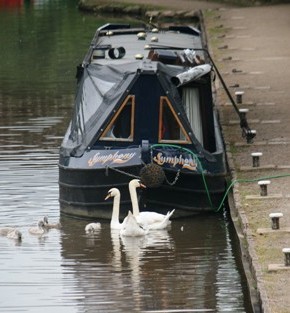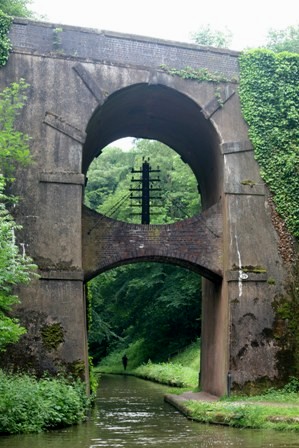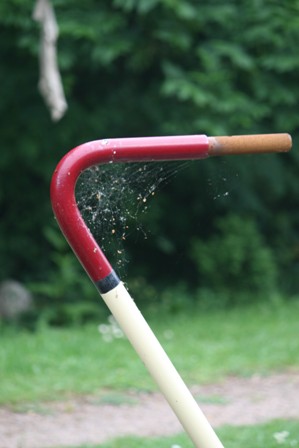
Serenity comes in all shapes and sizes but only one speed
Ring of muddy water
In the first year of the new millennium travel writer Paul Gogarty conceived an odyssey around England’s canals as the nation suffered floods, hurricanes and fuel strikes. Ten years later, with the nation facing mountainous debt, social disintegration and an unholy hybrid of a government, Mick Owen followed in his wake.

Serenity comes in all shapes and sizes but only one speed
In his book The Water Road, Paul Gogarty tells the story of an epic 900-mile journey around England’s waterways. His route takes in the rivers and canals that link London, Birmingham, Manchester, Leeds and the east midlands conurbation; his chosen craft is a hired holiday narrowboat. The result is a compelling narrative that mixes travelogue with social commentary and tells the tale of a life-changing journey. Earlier this year, I too embarked on a circular trip along ‘the Cut’, as boaters call the canal system, and was struck by how little has changed since Gogarty gave up four months of his life to an investigation of Britain’s water byways. Unlike Gogarty, however, I actually own a one-twelfth share in the boat that I used for my journey and even that is symbolic. The company who managed her (boats are all female) went bust just weeks after my investment had been made and she spent a week chained to a railing as “our” boatyard sought to get some of its debt repaid. It was, therefore, against a background of both personal and national uncertainty that NB Symphony slipped her moorings on the Macclesfield Canal – “the Macc” – and headed south.
Most canals have two names. There’s their Sunday-go-to-meeting names and then there’s the one by which the aficionado knows them. Thus the Staffordshire and Worcestershire Canal becomes “the Staffs and Wurts”, the Shropshire Union “the Shroppie” and so on. The key thing for the aspiring boater is to get to know this language early as belonging is as important on the Cut as it is in real life. It is a developing theme in Gogarty’s book that two Britains exist, often cheek by jowl, with the peace and goodwill of the waterways lost without trace in a two-minute walk from towpath to high street. “Why is it,” he asks in his own introduction, “that on some anonymous high street just fifty yards from the waterfront people hurry past each other seemingly persecuted by life and yet these same people walking the canal towpath smile and greet everybody they meet?” So if you are going to belong to a world, however tranquil and welcoming, one of the first things you need to acquire is the language. It has taken me ten years to use ‘the Cut’ without irony or self-consciousness and while I seldom pepper my speech with nautical jargon I am becoming comfortable with name-dropping ‘the cratch’, ‘the mid-line’ and ‘the weed hatch’, although I try to do this only when with other boaters to save confusing people back in the real world. It gives me an ‘in’ to the friendly, open-minded community of boaters who share the canals and, even with only five foot of floating real estate to my name, allows me to get beyond the long-suffering half-smile reserved for the “hire boaters”. Heirarchies exist in both worlds, water-born and landlocked.
The Water Road is an extended investigation of these two worlds but Gogarty’s journey is predicated on an investigation of the “hurry sickness” that separates these two Britains and it is only during the course of the book that he focusses increasingly on other differences. Two weeks cruising the Four Counties Ring – with a delightful detour “up the Llangollen” –convinced me, like Gogarty, that the key difference is not between fast and slow Britain but between rich and poor Britain. And its not a cigarette paper divide: it’s a gulf.
Canals were built to carry freight, not holiday-makers. Their current status is as relics of a more industrial society and their only modern relevance is as linear parks for the city dweller or alternative routes into the countryside for anyone who can afford to take them, whether by boat, by bike or on foot. Both roles are invaluable but their past also occasionally allows a third role – that of living museum. Cruise the Trent and Mersey through Stoke-on-Trent and the past becomes real; tired, decrepit and unexplained but real. The six towns of “the Potteries” were built on ceramics but the fine china of Wedgewood and Spode were produced in poverty and deprivation. Novellist Arnold Bennet catalogued the filth, fumes and repression that fuelled the industry, an industry that disgorged its product on to the canal system from wharves and jetties that can still be seen. Seen but not used, as any industry that still does exist now faces the road rather than the canal. Diminutive red-brick houses jostle factories and yards with the odd trademark bottle kiln, protected by man from man but still rotting under assault from nature and time.
Further south the picture is neither so positive nor so attractive. The Brittannia Stadium rises above its surroundings not because it’s a very big building, which it is, but because vast tracts of presumably former industrial sites around it have been razed to the ground with no replacement. Through this wasteland wander individuals and small groups, the canal towpath giving them their only direction. Under every arm is a large plastic bottle of the cheapest most potent cider and in every eye the distance and dislocation of drug abuse; if indeed it is abuse to recruit narcotic assistance to take you away from a reality consisting of worklessness, fractured family, industrial ruin and community-level hopelessness. The pristine tourist signs and shining interpretative boards that dot the canalside seem an inappropriate use of public money in an environment where girls farm out their babies to spend Saturday evening misconceiving another under a canal bridge. Like the shoals of ducklings that are such a feature of the late spring waterscape, the children of these children can have little clue as to who their father might be. Such is the nature of canal journeying that dystopia soon gives way to friendlier surroundings and the guilt of escape can be hurriedly forgotten in the plush of a middle England carvery and a couple of pints of dislocated London beer. But those kids are still there.
Away from the Stokes, the Kidsgroves and the Wolverhamptons, the balm of money soothes the waterside landscape. When not running through fields and woods – where cathedrals choired by birdsong vault above the boat – the canal slips by middle-class enclaves and coiffured lawns give way to endless decking replete with rustic furniture, hot tubs and even, in one sale director’s dream estate. a swimming pool under construction. The fat cat habit of conspicuous and contemptuous consumption is one that flows, like the Cut, a long way from Westminster.
The sense of being an observer not a participant in the world beyond the tunnel created by the canal and its towpath is the same whether passing commuter heaven or post-community hell. With each new version of England played out to either side the feeling that the Cut is another world grows. Narrowboaters are far from being the only people who populate this world, of course. The canals are also used for recreation by walkers, runners, canoeists and anglers. The sight of serried fishermen lifting their poles in a grudging Mexican wave to allow Symphony to tick past their pegs near Penkridge is surreal, as is the similarity between a Saturday morning junior canoe club outing at the mouth of the Harecastle Tunnel and the myriad families of ducklings skittering for the bank as we approached. So many people jog the towpath, some cheerily waving, some head down and determined not to break their internal impression that their effort matches Paula Radcliffes. So many dog walkers, duck feeders and gongoozlers* populate the towpath near any population centre. So much activity surrounds canals in good order that someone should make the case for them being prescribed as antidotes to society’s ills, at both the individual and the community levels, and preserved.
The fate of the waterways, like the fate of the entire country, is, right now, in the balance. British Waterways has become BW and the drive for best value has led to accusations of catastrophic cost-crimping on one side and Rachmanesque exploitation of assets on the other. Managing and maintaining the canals and their attendant infrastructure can be no easy task and BW’s detractors may have a chance to find out how difficult should plans to move to a social enterprise model become reality. The Cut is certainly a community but it is also a wider community asset; it certainly ticks the not-for-profit box. But keeping the 3,500 miles of waterway in good order and the growing number and variety of users in good humour is a job neither for the faint-hearted nor the gifted amateur; voluntary contributions of time and expertise may have been one mainstay of the canal revolution but alongside professional advice, planning and delivery. Talk of big society versus big government is well and good but releasing community assets into the hands of commercial asset-strippers or dumping hard-to-manage infrastructure onto voluntary groups and blaming them for the all too predictable negative result will risk, in the case of the canal system, an accelerating cycle of economically driven neglect, disuse and dilapidation. It will be a loss that can not be recouped.
Ten years after Paul Gogarty explored England’s canals and rivers and found a dislocated society struggling to comprehend or cope with a series of epoch-making disasters we struggle with a world full of corporation-made disasters against a background of indeterminate austerity at home and unending wars abroad. The yen to return to the alternative reality of the Cut is palpable. Gogarty describes his return to the inhumanity and hurry sickness of his real life with a chilling sense of dislocation: “I have reached the end of sanity, of slow time, of watching stars from my bed, of exchanging stories and assistance in lockgates, of waving to every passing boat.”
*gongoozler – person whose chosen recreation is to watch boats go by, usually found around lock flights.
Mick Owen is the managing editor of The Leisure Review.
The Water Road by Paul Gogarty is published by Robson Books in 2002 ISBN 1 86105 655 9
The Leisure Review, July 2010
© Copyright of all material on this site is retained by The Leisure Review or the individual contributors where stated. Contact The Leisure Review for details.
Download a pdf version of this article for printing

Taking it to the bridge

Taking things in hand: a tail for a tillerman